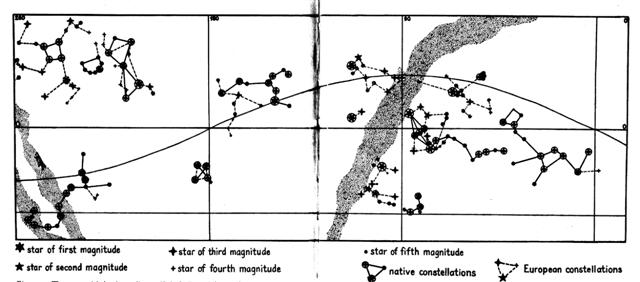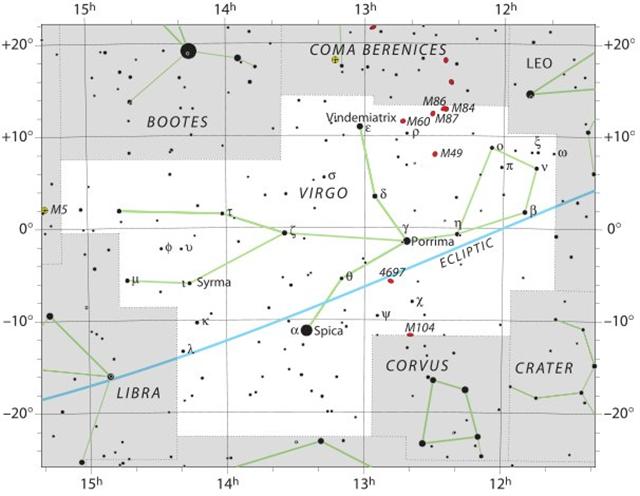A comparison between vaha mea in Gb7-25 (at Sheratan) and vaha mea in Ga1-4 (at Aldebaran) suggests a return (rebirth) from the nakshatra nights of Roman times could have begun in April 14:
There were 41 days from Sheratan to Aldebaran, 68 - 27 - 41, and the time of Bharani was 41 precessional days earlier than the time of rongorongo. The tresses of Pacha Mama had 32 days' difference between 214 (cfr October 21) and 182:
And in the C text κ Virginis was at glyph 5 on side b:
It was necessary to count with a year measuring 366 days in order to get the right ascension days agree with the glyph numbers, see for instance at heliacal Hamal.
... On February 9 the Chorti Ah K'in, 'diviners', begin the agricultural year. Both the 260-day cycle and the solar year are used in setting dates for religious and agricultural ceremonies, especially when those rituals fall at the same time in both calendars. The ceremony begins when the diviners go to a sacred spring where they choose five stones with the proper shape and color. These stones will mark the five positions of the sacred cosmogram created by the ritual. When the stones are brought back to the ceremonial house, two diviners start the ritual by placing the stones on a table in a careful pattern that reproduces the schematic of the universe. At the same time, helpers under the table replace last year's diagram with the new one. They believe that by placing the cosmic diagram under the base of God at the center of the world they demonstrate that God dominates the universe. The priests place the stones in a very particular order. First the stone that corresponds to the sun in the eastern, sunrise position of summer solstice is set down; then the stone corresponding to the western, sunset position of the same solstice. This is followed by stones representing the western, sunset position of the winter solstice, then its eastern, sunrise position. Together these four stones form a square. They sit at the four corners of the square just as we saw in the Creation story from the Classic period and in the Popol Vuh. Finally, the center stone is placed to form the ancient five-point sign modern researchers called the quincunx ... There were 5 stones (like stars) to be brought from a spring and arranged in the proper order. The last of them could have represented κ Virginis. ... Later on in this series of rituals, the Chorti go through a ceremony they call raising the sky. This ritual takes place at midnight on the twenty-fifth of April and continues each night until the rains arrive. In this ceremony two diviners and their wives sit on benches so that they occupy the corner positions of the cosmic square. They take their seats in the same order as the stones were placed, with the men on the eastern side and the women on the west. The ritual actions of sitting down and lifting upward are done with great precision and care, because they are directly related to the actions done by the gods at Creation. The people represent the gods of the four corners and the clouds that cover the earth. As they rise from their seats, they metaphorically lift the sky. If their lifting motion is uneven, the rains will be irregular and harmful ... Raising the sky was probably corresponding to make the rain (or Dead Man) return. ... There could have been an abrupt transfer of old winter from spring to the winter solstice, we have seen, to day 104 (April 14, 4-14) + 183 + 68 (precessional depth down to the time of Aldebaran) = 355 (December 21). And there could have been a complementary transfer of dead summer across to spring. The Babylonian zodiac illustrates how a bound and immobilized Dead Man will be carried along the path of the Milky Way ... His stars should be looked for at midnight, and therefore, in April 25 it could have been necessary to add 183 days minus (the mirror operation compared to addition) the precessional distance down to some cardinal star. 183 - 68 (Aldebaran) = 115 (April 25). Alkes (α in the Water Serpent, Hydra) culminated at midnight in April 20 with Zosma and Coxa following 4 nights later, and this should have been the sign to begin looking for rain.
... There was no water in the village. The lakes and rivers were dry. Raven and Crow, two young girls who were having their first menstrual courses, were told to go and draw water from the ocean. Finding the journey too long, Raven decided just to urinate into her basket-bucket. She decieved no one and was severly scolded. Crow returned much later but with drinking water. As a punishment, Raven was condemned never to find water in the summer; only in winter would she find something to drink. For that reason the Raven never drinks during the hot months; she speaks with a raucous voice because of her dry throat ... We can therefore assume the preceding quincunx ceremony represented the beginning of the dry season, measuring around *400 (April 25) - *325 (February 9) = 75 days. And we can guess the beginning of the C text on side b could follow the order of the Chinese list:
Spica was the star in the middle, Ana-roto.
|
|||||||||||||||||||||||||||||||||||||||||||||||||||||||||||||||||||||||||||||||||||||||||||||||||||||||||||||||||||||||||||||||||||||||||||||||||||||||||||||||||||||||||||||||||||||||||||||||||||||||||||||||||||||||||||||||||||||||||||||||||||||||||||||||||||||||||||||||||||||||||||||||||||||||||||||||||||||||||||||||||||||||||||||||||||||||||||||||||||||||||||
















